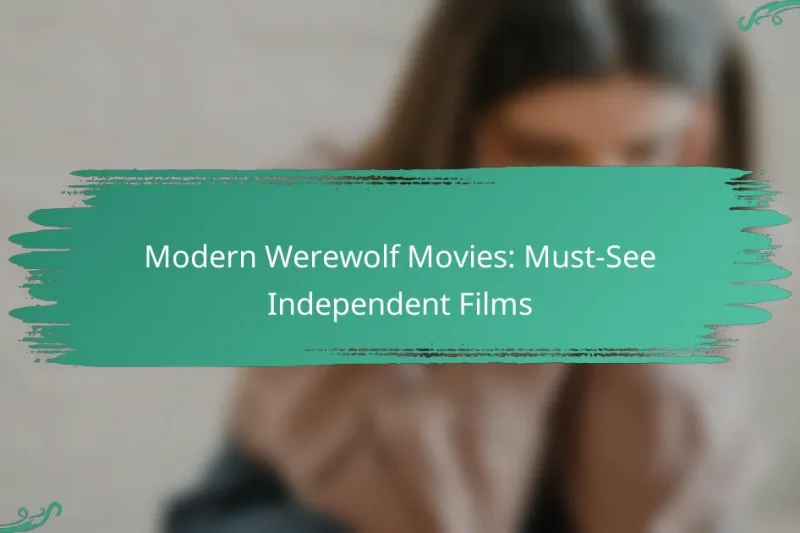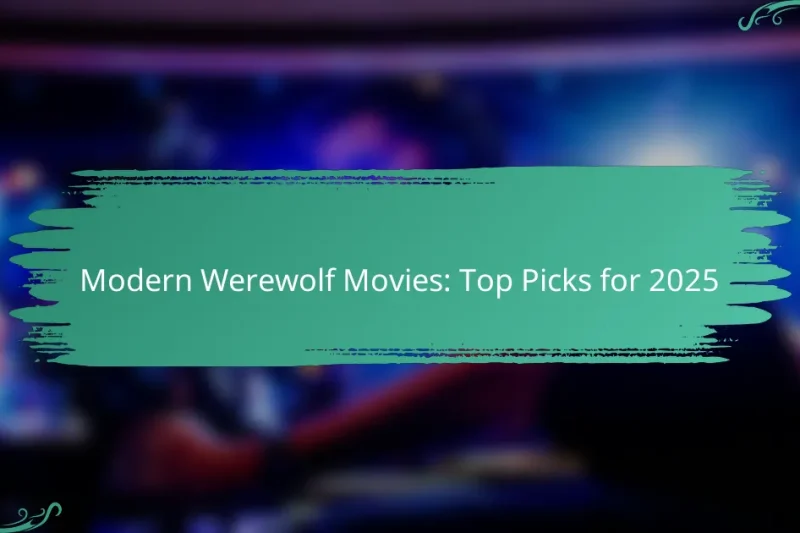Modern werewolf movies bring a refreshing twist to the classic horror genre, particularly through the lens … Modern Werewolf Movies: Must-See Independent FilmsRead more
Modern Werewolf Movies
Modern werewolf movies have evolved to blend horror with intricate storytelling, often focusing on themes of transformation and identity. Films like “The Wolf of Snow Hollow” and “Ginger Snaps” showcase unique interpretations of the werewolf mythos, exploring the complexities of human nature and the duality of existence. These narratives emphasize character depth and relevant social themes, distinguishing them from their classic predecessors.
Modern Werewolf Movies: Innovative Special Effects and Techniques
Modern werewolf movies have revolutionized the genre through innovative special effects that bring the terrifying transformation … Modern Werewolf Movies: Innovative Special Effects and TechniquesRead more
Modern Werewolf Movies: Top Picks for 2025
In 2025, several werewolf movies stand out for their unique storytelling and thrilling visuals. These films … Modern Werewolf Movies: Top Picks for 2025Read more
What are the best modern werewolf movies?
The best modern werewolf movies blend horror with unique storytelling, often exploring themes of transformation and identity. Notable titles include “The Wolf of Snow Hollow,” “Howl,” “Ginger Snaps,” “Late Phases,” and “The Howling: Reborn,” each offering a distinct take on the werewolf mythos.
“The Wolf of Snow Hollow” (2020)
“The Wolf of Snow Hollow” presents a fresh perspective on the werewolf genre, combining dark comedy with horror. Set in a small town grappling with a series of brutal murders, the film follows a sheriff who is determined to catch the killer, all while dealing with his own personal demons.
The film’s unique blend of humor and suspense, along with strong performances, particularly from the lead actor, makes it a standout. Its commentary on masculinity and vulnerability adds depth to the traditional werewolf narrative.
“Howl” (2015)
“Howl” is a gripping tale set on a late-night train journey that becomes a fight for survival against a werewolf attack. The film effectively builds tension as passengers are trapped and must confront their fears while battling the supernatural threat.
This movie is notable for its claustrophobic setting and character development, allowing viewers to connect with the protagonists. The practical effects used for the werewolf create a visceral experience that heightens the horror elements.
“Ginger Snaps” (2000)
“Ginger Snaps” is a cult classic that uses the werewolf transformation as a metaphor for adolescence and female empowerment. The story revolves around two sisters, with one undergoing a dramatic change after being bitten, leading to a rift in their relationship.
The film cleverly intertwines themes of puberty, sexuality, and societal expectations, making it resonate with audiences. Its blend of horror and dark humor, along with strong female leads, sets it apart from typical werewolf films.
“Late Phases” (2014)
“Late Phases” tells the story of a blind war veteran who moves to a retirement community plagued by mysterious deaths. As he investigates, he discovers that a werewolf is responsible, leading to a thrilling confrontation.
This film stands out for its unique protagonist and the exploration of aging and vulnerability. The werewolf lore is woven into the narrative in a way that feels fresh, and the film’s pacing keeps viewers engaged throughout.
“The Howling: Reborn” (2011)
“The Howling: Reborn” is a reboot of the classic franchise, focusing on a group of college students who uncover a dark secret about their town. As they delve deeper, they find themselves in a battle against werewolves that threatens their lives.
<pWhile it may not reach the heights of its predecessors, this film offers a modern take on the werewolf myth, with updated effects and a youthful cast. It appeals to a new generation of horror fans while paying homage to the original series.
What themes are explored in modern werewolf films?
Modern werewolf films often delve into themes of identity, transformation, and the struggle between isolation and community. These narratives explore the complexities of human nature and the primal instincts that emerge when one is faced with a dual existence.
Identity and transformation
Identity and transformation are central themes in werewolf films, highlighting the internal conflict between human and beast. Characters often grapple with their new identities, leading to profound self-discovery or tragic consequences. This theme resonates with audiences as it reflects the universal struggle of accepting oneself amidst change.
For example, a character might initially embrace their werewolf form, reveling in newfound power, only to later face the darker implications of their transformation. This duality emphasizes the complexity of identity in a rapidly changing world.
Isolation and community
Isolation and community are explored through the lens of the werewolf’s dual existence. Many films depict the werewolf as an outcast, struggling to connect with others while grappling with their monstrous side. This theme illustrates the tension between the desire for belonging and the fear of rejection.
In some narratives, the werewolf finds solace in a community of others like them, creating a sense of belonging that contrasts with their isolation. This dynamic can lead to powerful moments of camaraderie, but it also raises questions about loyalty and the sacrifices made for acceptance.
Nature versus nurture
The nature versus nurture debate is a recurring theme in modern werewolf films, questioning whether the beast within is an inherent trait or a product of one’s environment. Characters often face moral dilemmas that challenge their upbringing and instincts, leading to complex character arcs.
For instance, a character raised in a loving home may struggle to reconcile their violent urges with their nurturing background. This conflict invites viewers to consider how much of our behavior is shaped by genetics versus personal experiences, making the narrative deeply relatable.
How do modern werewolf movies differ from classic ones?
Modern werewolf movies typically emphasize character depth, advanced visual effects, and relevant social themes, setting them apart from classic films. While older werewolf stories often focused on the horror of transformation, contemporary narratives delve into the psychological and societal implications of lycanthropy.
Character development focus
In modern werewolf films, character development is a central theme, allowing audiences to connect with the protagonists on a deeper level. Filmmakers explore the emotional and psychological struggles of characters grappling with their transformations, often portraying them as tragic figures rather than just monsters.
This focus on character allows for more nuanced storytelling, where the werewolf’s condition serves as a metaphor for broader human experiences, such as identity crises or societal rejection. Examples include films where the werewolf’s struggle reflects issues like addiction or mental health challenges.
Special effects advancements
Advancements in special effects technology have transformed how werewolves are depicted on screen. Modern films utilize CGI and practical effects to create more realistic and visually striking transformations, enhancing the overall viewing experience.
For instance, films like “The Wolfman” and “Teen Wolf” showcase detailed fur textures and dynamic movement, making the werewolves appear more lifelike. This level of realism not only heightens the horror but also allows for more creative storytelling possibilities.
Social commentary integration
Modern werewolf movies often incorporate social commentary, addressing contemporary issues through the lens of the werewolf mythos. Themes such as alienation, discrimination, and the struggle for acceptance are frequently explored, making the stories resonate with current audiences.
For example, films might use the werewolf transformation as a metaphor for puberty, showcasing the challenges of growing up and fitting in. This integration of social themes adds depth to the narrative, prompting viewers to reflect on their own experiences and societal norms.
What are the common characteristics of werewolf films?
Common characteristics of werewolf films include themes of transformation, rural settings, and mythological references. These elements create a unique atmosphere that emphasizes the duality of human nature and the struggle between civilization and primal instincts.
Transformation scenes
Transformation scenes are a hallmark of werewolf films, showcasing the dramatic change from human to wolf. These sequences often involve intense physical effects, highlighting the agony and horror of the metamorphosis. Filmmakers may use practical effects, CGI, or a combination of both to create a visceral experience for the audience.
Effective transformation scenes typically last from a few seconds to several minutes, depending on the film’s pacing and style. Iconic examples include the slow, painful transformations seen in classics like “An American Werewolf in London” and the more rapid changes in modern adaptations.
Rural settings
Many werewolf films are set in rural areas, which enhance the sense of isolation and danger. These locations often feature dense forests, small towns, and remote cabins, creating an atmosphere of suspense and vulnerability. The contrast between the peaceful countryside and the lurking threat of the werewolf amplifies the tension.
Rural settings allow for a more primal exploration of fear, as characters are often cut off from help and must confront the beast alone. This isolation is a common trope that reinforces the struggle between humanity and the wild.
Mythological references
Mythological references play a significant role in werewolf films, drawing from various cultural legends and folklore. These films often incorporate elements from ancient stories about shape-shifting and the supernatural, enriching the narrative with historical context. Common themes include the curse of lycanthropy and the moral dilemmas faced by those afflicted.
Understanding these mythological roots can deepen the viewer’s appreciation of the film. For instance, many stories reference the full moon as a trigger for transformation, a detail that has become a staple in werewolf lore. This connection to mythology adds layers of meaning and can influence character motivations and plot development.
What are the top werewolf movie franchises?
The top werewolf movie franchises include iconic series that have shaped the genre, each offering unique takes on the werewolf mythos. Notable franchises like “Underworld,” “American Werewolf,” and “Wolfman” have captivated audiences with their blend of horror, action, and fantasy elements.
“Underworld” series
The “Underworld” series combines werewolves with vampires, creating a rich narrative filled with action and drama. Starting with the first film in 2003, this franchise explores the centuries-old conflict between these two supernatural factions.
Key films in the series include “Underworld” (2003), “Underworld: Evolution” (2006), and “Underworld: Blood Wars” (2016). Each installment builds on the lore, introducing new characters and expanding the universe, making it a compelling choice for fans of action-packed horror.
“American Werewolf” series
The “American Werewolf” series is known for its blend of horror and dark comedy, starting with “An American Werewolf in London” (1981). This film is celebrated for its groundbreaking special effects and memorable transformation scenes, setting a high standard for werewolf films.
Although the franchise has fewer entries, its impact is significant, with a sequel, “An American Werewolf in Paris” (1997), that attempts to capture the original’s charm. The series is often recommended for those who appreciate a mix of humor and horror in their werewolf narratives.
“Wolfman” series
The “Wolfman” series, particularly the classic “The Wolf Man” (1941), has been foundational in establishing werewolf lore in cinema. This franchise emphasizes the tragic nature of the werewolf, focusing on the internal struggle of the character.
Recent adaptations, such as “The Wolfman” (2010), have attempted to modernize the story while retaining its gothic roots. Fans of classic horror will find this series appealing due to its atmospheric storytelling and iconic monster design.


